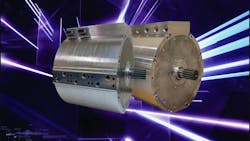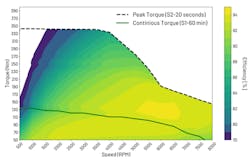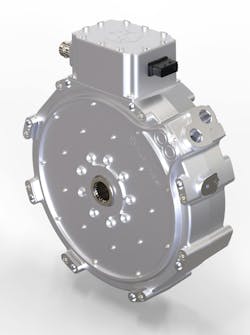Continuous Torque Drives Peak Performance
What you’ll learn:
- Continuous torque: The power behind axial-flux motors.
- Applications that benefit from ideal continuous torque.
When you hear the term continuous torque, you may not realize just how crucial a role it plays in keeping operations running smoothly, creating a steady and reliable force for seamless operation of your machines.
Continuous torque is vital in motor design and application, representing the maximum torque that a motor can deliver consistently without overheating or sustaining damage. It ensures that motors operate efficiently and reliably under constant load conditions, providing stability in performance.
Motors have different duty cycles (S1 to S10). The S1 duty cycle is particularly important because it defines continuous torque—the continuous operation of a motor under constant load once thermal equilibrium is reached. Typically measured over a duration of 60 minutes, the S1 cycle serves as the benchmark for assessing a motor's ability to deliver uninterrupted torque while maintaining safe operating temperatures (Fig. 1).
Continuous Torque: The Power Behind Axial-Flux Motors
As the electrification of equipment accelerates, balancing time-to-market with durability and performance is critical. Axial-flux motors deliver high torque density and efficiency in a compact, flat, disk-like design. Their unique design allows them to provide high torque in smaller form factors compared to traditional radial-flux motors.
Such a form factor makes these motors valuable in space-limited, high-performance scenarios like off-highway equipment, industrial machinery, and premium electric vehicles.
This is important for design engineers because of its:
- Efficiency and performance: Axial-flux motors are known for their high efficiency and power density. Maintaining axial-flux motor continuous torque ensures that the motor operates efficiently under constant load conditions, which is essential for applications requiring sustained performance.
- Thermal management: Continuous torque ratings help manage the thermal load on the motor. Axial-flux motors, with their compact design, can generate significant heat. Ensuring that the motor operates within its continuous-torque limits prevents overheating and potential damage.
- Application suitability: Many applications of axial-flux motors such as electric vehicles (EVs) and industrial machinery require consistent and reliable torque output. Continuous-torque ratings help ensure that the motor can handle these demands without performance degradation.
- Design optimization: The design of axial-flux motors—including the arrangement of magnets and coils—is optimized to deliver high torque in a compact form. Continuous-torque ratings help in designing motors that can sustain high torque over long periods, maximizing their utility in various applications.
Continuous torque is dictated by the continuous current rating, which is limited by thermal constraints (cooling, resistance losses, and winding temperature). Voltage doesn’t directly affect torque, but it determines the ability to supply current at higher speeds.
Higher voltage enables the motor to operate at higher speeds while maintaining torque by overcoming back electromotive force—the voltage generated by a source, such as a battery or an electric motor, that causes current to flow in a circuit. It’s measured in volts and represents the energy per unit charge supplied to move electrons through the circuit.
Applications Benefiting from Ideal Continuous Torque
Continuous torque is important in many applications where sustained performance and reliability are essential in ensuring the efficiency and safety of various systems and applications:
- High-performance and premium electric vehicles (EVs) rely on continuous torque to provide smooth, consistent acceleration and maintain speed, especially during long drives. It ensures that the vehicle can handle varying loads and driving conditions without being subjected to overheating.
- Recreational vehicles, including motorcycles, go-karts, snowmobiles, and personal watercraft, benefit from electrification through improved power delivery, responsiveness, and reduced environmental impact and noise. All are supported by continuous torque performance.
- Military and combat applications gain strategic advantages from continuous-torque motors, which enable extended range without refueling and quieter operation for enhanced stealth.
- Marine engines and propulsion systems leverage continuous torque to provide steady thrust and maneuverability across long distances. This is particularly important for commercial ships and submarines.
Important Role of Continuous Torque in High-Performance Engineering
High-continuous-torque axial-flux motors represent the future of high-performance vehicles and equipment (Fig. 2). Their ability to deliver consistent, reliable power while maintaining efficiency and compactness makes them indispensable across many industries.
For manufacturers, they offer a clear path to electrification and hybrid systems with superior performance, durability, efficiency, and space optimization. As technology continues to evolve, these innovative solutions will play a pivotal role in driving peak performance and setting new standards for reliability and excellence.
About the Author

Matrishvan Raval
Head of Product, Turntide Technologies
Matrishvan Raval is Head of Product at Turntide Technologies, bringing over a decade of experience in engineering and leadership roles across the automotive and aerospace sectors. He has held positions at McLaren Applied, GE Aviation, Meggitt, and Rolls-Royce, leading global teams and advancing embedded systems and Agile practices.
Matrishvan holds Bachelor of Engineering and Master of Science degrees from the University of Leicester, where he also served as a Visiting Design Professor. He further honed his leadership skills through programs at Harvard Business School and the University of Oxford’s Saïd Business School, focusing on general management and executive leadership.


